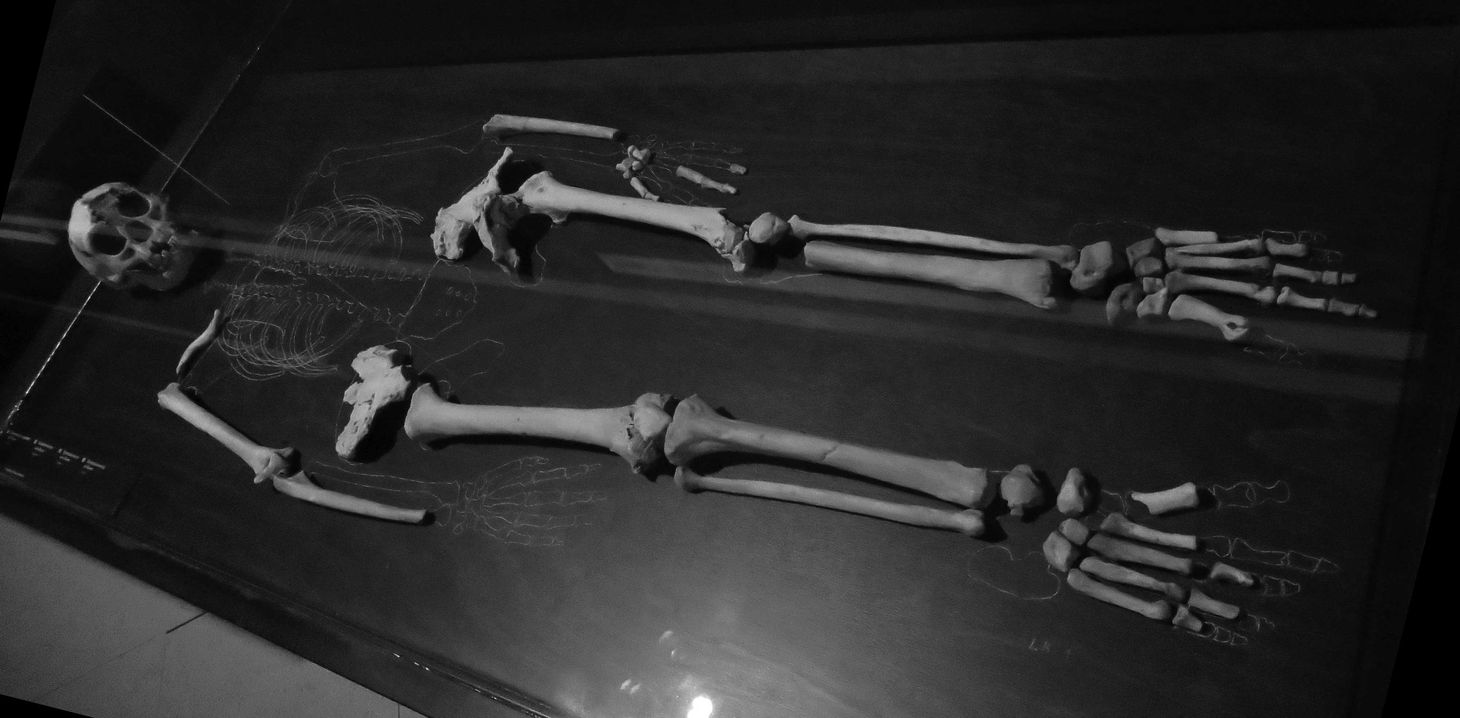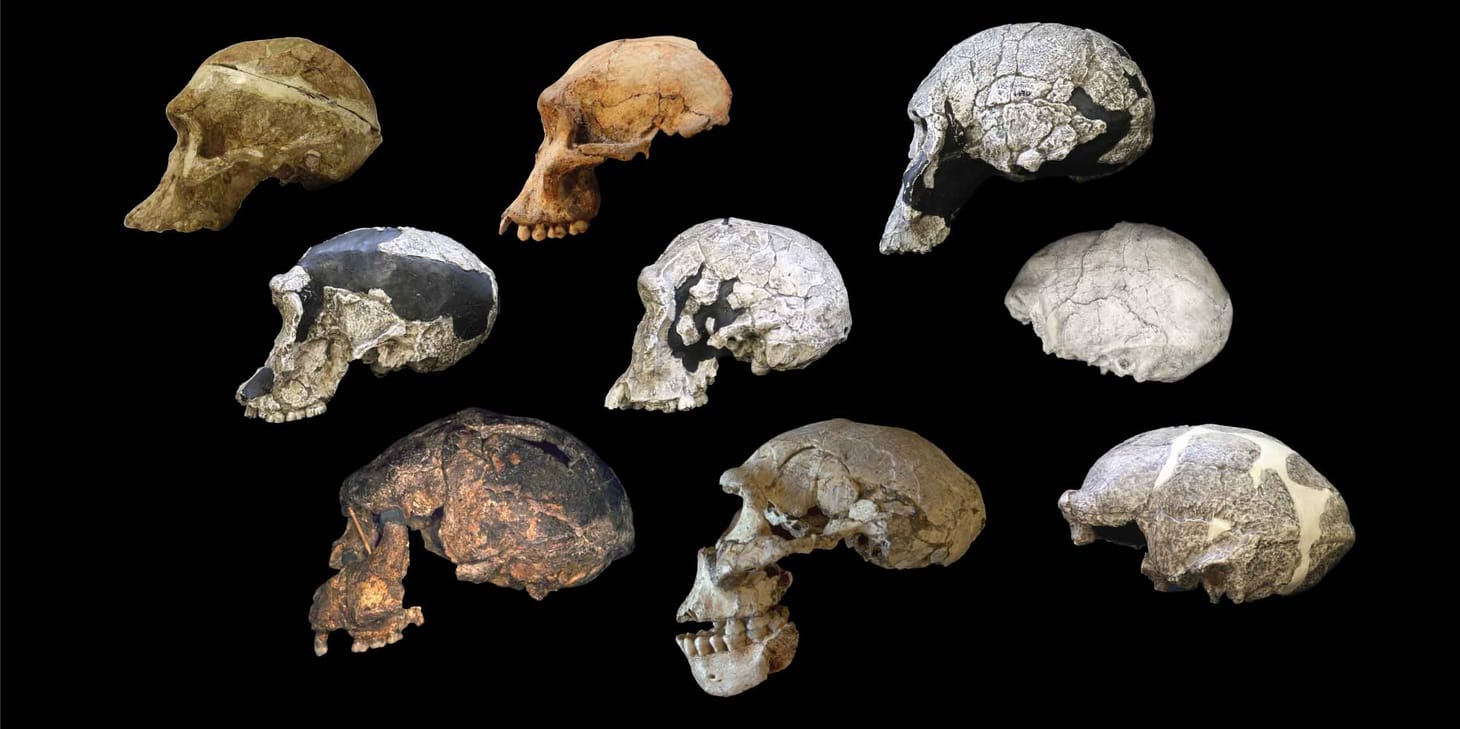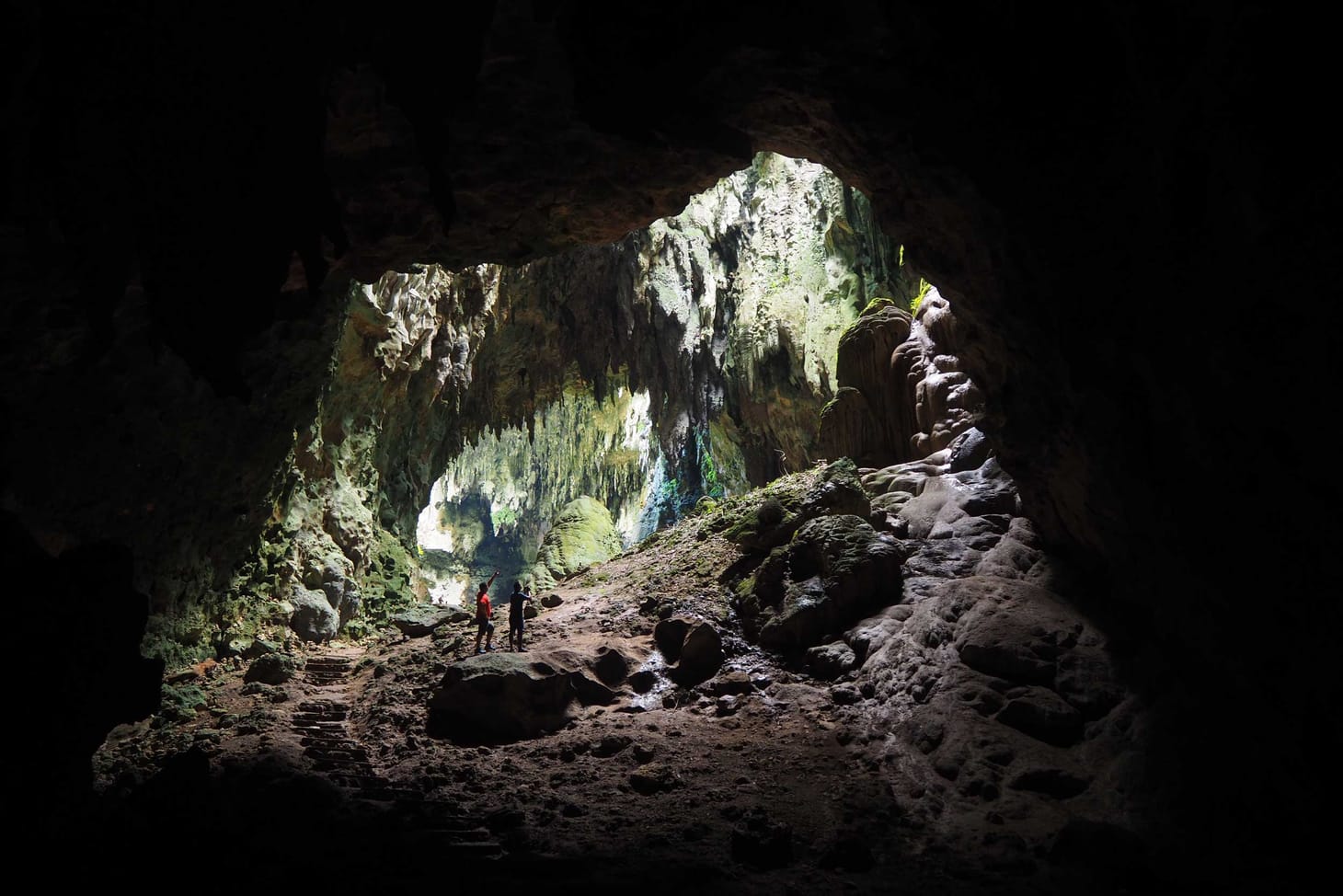The Homo floresiensis discovery, an initial FAQ
I answer questions about whether the small hominin is a dwarfed descendant of Homo erectus or something else.

Note: I wrote this post the day that the papers describing Homo floresiensis and its context in Liang Bua cave came out in Nature in 2004. From the perspective of the blog’s history, this is the earliest large science post that I did. As you can imagine, much more information has come to light since that discovery. I have left the post in its original form as a historical reference. Later posts and other sources provide much more current information. Research since the 2004 discovery has resolved some uncertainties and errors reported in these research papers.
Here are some questions and likely answers about the Liang Bua (LB1) skeleton from the island of Flores.
Why is the skeleton an important story?
The skeleton is australopithecine-sized, with an estimated mass of 35 kg and an estimated stature of 1 meter. The brain matches the smallest yet known for any hominin, at 380 mL. Yet it is 6000 miles from the nearest australopithecine site, and lived 1.5 million years later than any known australopithecine–it is only around 20,000 years old!
Where is Flores?
Flores is in present-day Indonesia, on the east side of Wallace’s line. This means that Flores was never connected by land to the islands of Java or Borneo. This is significant because Java was connected by land to Asia during periods of low sea level in the Pleistocene, and supported a long-lasting population of hominins. Flores was never connected, and archaeological remains on Flores as early as 800,000 years old have led some scientists to suggest that humans must have developed watercraft by that time. With the current find, it is unclear whether the earlier archaeological remains were left by the ancestors of LB1 or by some other hominin.
Is LB1 an ape?
LB1 is certainly not an ape. The pelvis and femur are entirely compelling in their adaptations to obligate bipedality. The skull possesses no unique similarities with the only great ape in the region, the orangutan. Although the size of the brain is consistent with an orangutan or other ape, the anatomy of the specimen rules out this hypothesis.
What are the chances it is significantly older than 20,000 years?
This is impossible to say without a first-hand knowledge of the site. I have no reason to doubt the date as given. Considering the excellent preservation of the skeleton, there is no obvious inconsistency with the date.
Is LB1 descended from Javan Homo erectus?
Flores is close to Java. So the earlier Javan hominins are in the right place and at the right time to be ancestral to LB1. But aside from this temporal and geographic argument, there is no reason to believe that any known Javan hominins are among the ancestors of LB1.
Hominins on Java are typically assigned to H. erectus because they share a high frequency of certain distinctive characteristics. These include a long, low cranium, sagittal keel, bar-like supraorbital torus, a flat frontal bone with no groove (called a sulcus) above the supraorbital, strong muscle attachments on the cranial vault forming a distinct nuchal torus and angular torus, strong total facial prognathism, complex-crowned teeth, and a low cranial breadth with strongly pneumatized bone at the cranial base. Not all of these features are found uniquely in Java–most are shared with one or more other human samples. But their high frequency in this region makes them markers of human evolution in this part of the world.
LB1 has only one of these features characteristic of Javan hominins—the maximum breadth of the skull is at its base and it is slightly pneumatized. But that feature is also shared with australopithecines. It shows no special relationships to earlier hominins from Java, and is just as different from them as it is from any other kind of human. So from my perspective, I see little evidence to support the idea that LB1 is a descendant of earlier Javan H. erectus.
Is LB1 an insular dwarf?
Insular dwarfs are forms of large mammals that have been isolated on islands that are relatively small compared to the normal geographic ranges of those mammals. There is no hard and fast rule about what kinds of animals are likely to evolve dwarfism when they are isolated. Strange things can happen on islands depending on the composition of the fauna and the available resources. Thus, many kinds of animals experience insular giantism (such as the Komodo dragon on Flores itself or the dodo on Mauritius, which was a giant relative of the pigeon). Some experience dwarfism, such as the Holocene mammoths of Wrangell Island (off Siberia) or the Catalina islands (off California).
It is not clear whether any human populations have experienced insular dwarfism. At one time or another, anthropologists have suggested various populations as the descendants of larger ancestors that underwent insular dwarfing, including the Negritos of the Andaman Islands, Malay Peninsula, and Phillipines. But these people have mainland relatives who are also small. There are also cases where no dwarfism resulted even after very long periods of life on islands, such as precontact Tasmania.
Is LB1 a dwarf at all?
The biggest problem with the hypothesis of insular dwarfing of H. floresiensis is its small brain size. It is not uncommon for mammals to evolve smaller body size. However, selection for smaller body size has only a limited effect on the brain, because brain size and body size have a limited genetic correlation. This limits the response of brain size to both increases and decreases in body size, so that within genera of mammals, brain size scales only at about 20 percent or less of the magnitude of any change in body size. If H. floresiensis had followed the pattern of most mammals, a decrease to half the body size of its ancestor would result in only 10 percent smaller brain size. This scaling is more or less what we observe when we look at small human populations, such as the Pygmy populations in central Africa or the Negritos. Their brain sizes are smaller, but still within around 10% of the average of larger-bodied people.
If we suppose that LB1 evolved from an early human form such as Javan H. erectus, its body mass would be a bit more than half that of the ancestral population. Javan H. erectus has an average endocranial volume of around 800 ml, and a dwarfed population would be around 10% smaller, a bit more than 700 ml. The LB1 endocranial volume is around 410 ml. In other words, the LB1 brain is much smaller than it should be if it were descended from H. erectus with allometric decrease in brain size alone. Some of this difference might be accounted for if LB1 were a very small-brained member of her population. Still, this brain is nearly as small as recorded for any australopithecine.
So if LB1 were a phyletic dwarf, meaning that it belonged to a small-bodied population derived from large-bodied early humans, then it must have also undergone selection in favor of smaller brains.
It would be very unusual for this pattern of selection to affect a primate. For example, small New World monkeys like marmosets and tamarins are phyletic dwarfs whose body sizes are greatly decreased relative to other platyrrhines. However, they retain relatively large brain sizes for the size of their bodies. These brain sizes function effectively to make marmosets and tamarins among the clearest experimental models of social learning. Social learning, tool use, and other cultural phenomena are very important to living apes and humans. We tend to think that our large brains facilitate these behaviors. It would be counter-intuitive for a population of hominins to reduce its brain size by as much as 50%, if those brains really were essential for social and technical behaviors. The presence of stone tools on Flores, which may have been produced by this very population, make the interpretation of selection for smaller brains even more questionable.
Does LB1 represent a population of small-bodied, small-brained hominins?
It is important to keep in mind that these considerations assume we are talking about a population, not just an unusual individual. If we reject the hypothesis of pathology (considered below), then I would assume that LB1 represents a small female member of a population that probably had a mean body size and mean brain size somewhat larger. I have it from more than one source that there are several additional partial skeletons that are similar in body size to the first. This would substantiate the idea that a small-bodied population did exist on Flores, although the brain sizes of any additional individuals have not been passed along.
Is LB1 pathological?
Pathological dwarfism has some of the same implications as phyletic dwarfism. Achondroplasia and other modes of dwarfism among living humans do not result in greatly smaller brain sizes. There are disorders that result in very small brain sizes, but they do not typically lead to the scale of body size found in this specimen. The oddly squared premolars, the thick but variable skull thickness may point to a pathological explanation, but I cannot yet match this set of morphological symptoms with any single characterized disorder. Pathology would make a convenient explanation, but it cannot as yet be confirmed. The fact that similar-sized individuals may also be represented makes the pathology explanation much less likely.
Is LB1 an australopithecine?
No australopithecines are known outside of Africa, and none are known later than 1.4 million years. Although early paleoanthropologists like von Koenigswald believed that some of the Javan mandibular remains represent an australopithecine species, which they called Meganthropus, paleoanthropologists since have shown that those mandibular remains fit within the range of early Homo. So there is no known relict population of australopithecines in Southeast Asia that could have survived and given rise to LB1.
Nevertheless, the brain size and body size of LB1 are very much like African australopithecines like Australopithecus afarensis. If it is implausible that a population of individuals like LB1 could have descended from early humans, it would be simple to derive such a population from an australopithecine. My own feeling is that if this skeleton does represent a hominin population like it, then it is likely that was an australopithecine population.
There are few features that specifically point to an australopithecine relationship, however. The sizes of the teeth are markedly reduced compared to fossil Australopithecus, especially so for the molar teeth. These molars reduce in size from the first to the third molar, which is not found in any australopithecine species, or for that matter in any hominin before Homo sapiens. The jaw and facial robusticity is also small. The key features that are australopithecine-like are the great breadth of the pelvis, including a projecting anterior superior iliac spine, a long femur neck and a mandibular symphysis described as very similar to the Au. afarensis mandible Laetoli hominin (LH) 4. The postcranial resemblances to australopithecines are frankly not compelling, because they may result from a small body size.
In short, the main reason to think the skeleton is an australopithecine is its small brain size. In my view, this would be enough–assuming the specimen is not pathological–because I view it as inherently unlikely that a hominin population could reduce so radically in brain size. But reasonable people certainly disagree about the validity of that assumption. Beyond this, there is little compelling evidence that this skeleton possesses any distinctly australopithecine features, although it has many that are shared by australopithecines and early humans.
This could, by the way, be settled with a single mtDNA sequence.
Is there any prospect of retrieving DNA from the skeleton?
A single sequence of mtDNA from one of the specimens would be very informative about their relationships. The prospect seems unlikely because DNA degrades more rapidly in warm tropical environments. The oldest-known fossil human DNA is from Europe, dating to as early as 40,000 years. Likewise, some DNA is known from Late Pleistocene Australians, although preservation there may have been aided by relatively arid conditions. From tropical islands, DNA can degrade in as little as a few dozen years. The preservation of this skeleton in a cave context may make it more likely to harbor DNA, and it is certainly possible. However, the site is substantially removed from the conditions that are known to enhance DNA survival.
Is this find worthy of a new species?
Its discoverers have named it Homo floresiensis. There is no way that these hominins were conspecific with humans–they are just too anatomically different. If humans are different species than australopithecines, they are different species from these hominins, regardless of their date. I would tend to think that their brain size might justify putting them in a different genus. The fact that they share toolmaking and hunting with humans does not necessarily justify placing them in the same genus, since some members if Australopithecus (or Paranthropus) also probably used tools and ate significant amounts of meat. Also, several paleoanthropologists suggest that Homo habilis should be removed from Homo and placed into Australopithecus. So a genus-level distinction might well be appropriate.
Personally then, I would have gone with something more daring–if they are calling them hobbits, then why not Hobbit floresiensis? One might even suggest that if their most recent common ancestor with us is close to the first toolmakers, then Homo habilis might well be placed into Hobbit along with H. floresiensis. Hobbit habilishas a nice ring to it, and is no less true of them then of H. floresiensis with similar body size and slightly larger brains.
References
Brown, P., Sutikna, T., Morwood, M. J., Soejono, R. P., Wayhu Saptomo, E., & Awe Due, R. (2004). A new small-bodied hominin from the Late Pleistocene of Flores, Indonesia. Nature, 431(7012), 1055-1061. https://doi.org/10.1038/nature02999
Morwood, M. J., Soejono, R. P., Roberts, R. G., Sutikna, T., Turney, C. S., Westaway, K. E., ... & Fifield, L. K. (2004). Archaeology and age of a new hominin from Flores in eastern Indonesia. Nature, 431(7012), 1087-1091. https://doi.org/10.1038/nature02956
Mirazón Lahr, M., & Foley, R. (2004). Human evolution writ small. Nature, 431(7012), 1043-1044. https://doi.org/10.1038/4311043a
John Hawks Newsletter
Join the newsletter to receive the latest updates in your inbox.



